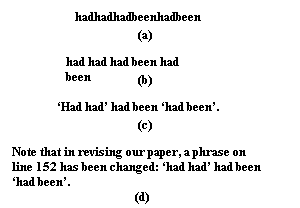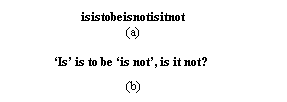7.6.1 CONTEXT AND CORPORATE MEMORY
7.6.1.2 THEORY ABDUCTION
Context, in whatever form it was developed, can help rebuild the route to theory. Context is an important consideration in the provision of a corporate memory, yet the meaning of context it is just as elusive as the meaning of meaning itself. Information as data, classes, models, rules, theory, placements, or even metaphors resides at various stratums of abstraction. These information entities may be inter-related perhaps through derivation or mapping, but the process of their development, the process of theory development is mostly lost.
As an example of the process of theory abduction, Figure 85 illustrates the abstraction of line data to a point where a meaningful statement is present. Figure 85 (a) can be considered as line data, but there is immediate cognition that there is a pattern and that these are letters. The transformation of these letters to words and then into a sentence is illustrated by Figure 85 (b) and Figure 85 (c). At this point, there is no context. But given that this sentence is a comment found upon a proofed paper, more sense can be made of it. Figure 85 (d) actually places the statement into a context.
Figure 85 Theory Development (a) Letters, (b) Words, (c) Sentence, and (d) Context

Figure 86 traces the inductive transformation flow, and possible alternative routes that could have been taken. The line data could have been interpreted as a bar code rather than letters. The letters could have been interpreted as a DNA sequence rather than words. And the words could have been interpreted as a particular word frequency listing from the parse of a text. Finally, the sentence is interpreted in the context of a proof-reading session.
Figure 86 The Inductive Transformation Process

Figure 87 Application of Theory from Data (a) to 'Meaningful' Sentence (b).

With the presence of context, the abstraction process from data to theory can be reconstructed more effectively. In the proof-reading example, context is an important clue to characterizing the data. But context is just another model. There must be some mechanism to capture and store the theory-making process. Context may aid in reconstructing the process, but it in no way represents the process itself.
Rules originally are abstracted from the data. But when rules are applied to the data to characterize the data, the rule is being used as a theory. The distinction between rules and theory is not in their relative order on the scale of abstraction, but rather in the application: rules formulate the world while theory and law tends to define it.
If the abstraction process from data to theory to even law can be conceived as layered horizontal planes, the process of abstraction vertically cuts through and connects these planes. We have seen how data is stored, how rules can be stored, and even how theory is embodied within computational software and stored. But what is not stored is the vertical abduction process.
The reason abduction is important is that when the data changes, the rules and theory may have to be adjusted to accommodate. Theory is contingent on the data supporting it. While more settled than the rules of heuristics, theory has the capacity to be modified or even discarded as new evidence is brought to light.
Theory deductively influences data and data inductively influences theory. The dialectic nature of the design process reveals an interplay evident in the hermeneutic circle, where language influences the way a society thinks - its theory of the world - and the way a society thinks influences the language it uses.
There is difficulty in storing the abduction in that the hermeneutic cycle is so dynamic. Theory and classification often defines the data, which in turn defines the theory. Theory development, as a process, embodies this cycle.
Currently, in various collaboration projects, attempts are made to store everything connected to the design process and make all parts of the process available to a parties concerned. This is similar to the DFM design folder. While this opens the design process and increases the design archives, it remains to be seen how this approach affects the design process. Openness does not fundamentally address the capture of theory development; work remains to be done in this area.